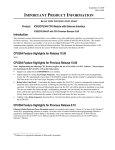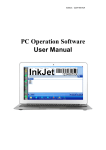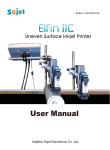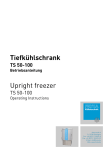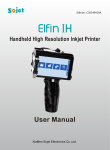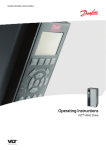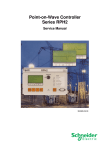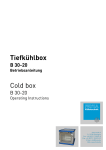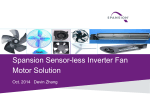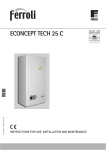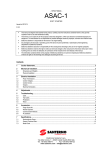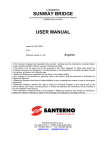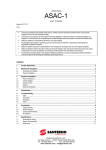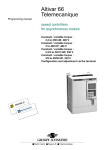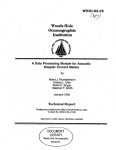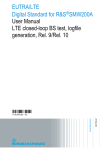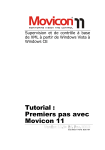Download POWER PLANT CONTROLLER
Transcript
POWER PLANT CONTROLLER USER MANUAL Issued on: 17/04/2014 English Rev. 00 • This manual is integrant and essential to the product. Carefully read the instructions contained herein as they provide important hints for use and maintenance safety. • This product is to be used only for the purposes it has been designed to. Other uses should be considered improper and dangerous. The manufacturer is not responsible for possible damages caused by improper, erroneous and irrational uses. • Elettronica Santerno is responsible for the product in its original setting. • Any changes to the structure or operating cycle of the product must be performed or authorized by Elettronica Santerno. • Elettronica Santerno assumes no responsibility for the consequences resulting by the use of nonoriginal spare-parts. • Elettronica Santerno reserves the right to make any technical changes to this manual and to the product without prior notice. If printing errors or similar are detected, the corrections will be included in the new releases of the manual. • The information contained herein is the property of Elettronica Santerno and cannot be reproduced. Elettronica Santerno enforces its rights on the drawings and catalogues according to the law. Elettronica Santerno S.p.A. Via della Concia, 7 - 40023 Castel Guelfo (BO) Tel. +39 0542 489711 - Fax +39 0542 489722 santerno.com [email protected] POWER PLANT CONTROLLER User Manual TABLE OF CONTENTS 1. GENERAL INFORMATION ON THE PRODUCT...................................................... 4 1.1. CABINET IDENTIFICATION AND RATINGS............................................................ 4 1.2. MAIN FUNCTIONS STANDARDLY INCLUDED ....................................................... 5 1.3. NAMEPLATE............................................................................................................ 5 1.4. FOR WHOM THIS MANUAL IS INTENDED ............................................................. 6 1.5. ATTACHED DOCUMENTATION .............................................................................. 6 1.6. PRESERVATION OF THE DOCUMENTATION ....................................................... 6 1.7. ELECTRICAL AND MECHANICAL SCHEMATIC ..................................................... 7 1.8. TEST CERTIFICATE ................................................................................................ 9 1.9. SYMBOLS USED IN THIS MANUAL ........................................................................ 9 1.10. DEFINITIONS........................................................................................................... 9 2. CAUTION STATEMENTS ....................................................................................... 10 2.1. INTENDED USE..................................................................................................... 11 2.2. QUALIFIED TECHNICAL PERSONNEL................................................................. 11 2.3. EXECUTION OF WORK ........................................................................................ 11 2.4. ACCESSING THE EQUIPMENT: SAFETY PROCEDURE ..................................... 12 3. TECHNICAL DATA ................................................................................................. 13 3.1. ENVIRONMENTAL REQUIREMENTS FOR INSTALLATION AND STORAGE ...... 13 3.2. ELECTRICAL SPECIFICATIONS OF THE CABINET............................................. 13 3.3. MECHANICAL SPECIFICATIONS OF THE CABINET ........................................... 14 3.4. ELECTRIC AND COMMUNICATIONS INTERFACE .............................................. 14 4. HANDLING AND MOUNTING ................................................................................ 15 4.1. HANDLING CONDITIONS...................................................................................... 15 4.2. HANDLING USING A PALLET JACK OR FORKLIFT TRUCK................................ 15 5. INSTALLATION ...................................................................................................... 16 5.1. IDENTIFYING THE FUNCTIONAL VOLTAGE OF THE CIRCUITS INTERNAL TO THE EQUIPMENT .................................................................................................. 16 5.2. DESCRIPTION OF THE CABINET......................................................................... 17 5.3. GROUNDING ......................................................................................................... 19 5.4. POSITIONS OF THE TERMINAL BOARDS FOR THE CONNECTION OF THE INCOMING CABLES .............................................................................................. 19 5.5. CABLE ENTRY ...................................................................................................... 20 5.6. CABLE CROSS-SECTIONS................................................................................... 21 5.7. TERMINAL FUNCTIONS FOR SANTERNO PPC 15 ............................................ 21 5.8. TERMINAL FUNCTIONS FOR SANTERNO PPC 180 .......................................... 23 5.9. SWITCHES INSTALLED ON THE POWER PLANT CONTROLLER ...................... 24 2/45 Rev. 00 - 17/04/2014 User Manual POWER PLANT CONTROLLER 5.10. ETHERNET TCP/IP COMMUNICATIONS INTERFACE WIRING........................... 25 5.11. CABINET VENTILATION ....................................................................................... 26 5.12. COMMANDS ON THE CABINET FRONT .............................................................. 27 6. MAINTENANCE ...................................................................................................... 28 6.1. MAINTENANCE SHEET ........................................................................................ 28 6.2. CHECK THE EXTERNAL/INTERNAL CONDITIONS OF THE CABINET ............... 29 6.3. AIR FILTER MAINTENANCE ................................................................................. 30 6.4. CHECKING THE SEALS, LOCKS AND HINGES ................................................... 31 6.5. CHECK THE FAN .................................................................................................. 31 6.6. CHECKING CONTROL AND AUXILIARY VOLTAGES (24 VDC 230 VAC) ........... 32 6.7. CHECKING THE RELAYS AND SWITCHES ......................................................... 32 6.8. CHECKING THE TIGHTENING TORQUE ............................................................. 33 7. DESCRIPTION OF THE HMI .................................................................................. 34 7.1. NAVIGATION BAR ................................................................................................. 34 7.2. PASSWORD .......................................................................................................... 35 7.3. DESCRIPTION OF THE HMI PAGES .................................................................... 36 7.3.1. ALARMS AND WARNINGS ......................................................................................... 37 7.3.2. PLANT DATA ............................................................................................................... 40 7.3.3. TREND ........................................................................................................................ 41 7.3.4. CONFIGURATION MENU ........................................................................................... 42 7.3.5. SET POINT .................................................................................................................. 43 7.3.6. SERVICE ..................................................................................................................... 44 8. DATA TRANSFER VIA MODBUS TCP/IP PROTOCOL ......................................... 45 Rev. 00 - 17/04/2014 3/45 POWER PLANT CONTROLLER User Manual 1. GENERAL INFORMATION ON THE PRODUCT WARNING For a correct and risk-free use of the equipment, make sure that all the parameters provided by the manufacturer are respected and that all the check procedures and test procedures are carried out according to the instructions provided. 1.1. Cabinet Identification and Ratings SANTERNO PPC 15 cabinet. May control up to 15 inverters. SANTERNO PPC 180 cabinet. May control up to 192 inverters. The cabinet is provided with a hinged door allowing 120° opening. 4/45 Rev. 00 - 17/04/2014 User Manual 1.2. POWER PLANT CONTROLLER Main Functions Standardly Included • Auxiliary services power supply and low voltage distribution • Interface point for the connection to the external network for the remote monitoring services • Equipment control via PLC • HMI, touch panel 1.3. Nameplate The cabinet nameplate provides all the technical and identification data. - Part Number assigned to the equipment by Elettronica Santerno. - CE mark and list of the Regulations applicable to the construction of the equipment (CE is a collective registered mark). - Serial Number of the equipment - Cabinet specs The nameplate is silver-coloured and measures 100x70mm. Example of a nameplate: Rev. 00 - 17/04/2014 5/45 POWER PLANT CONTROLLER 1.4. User Manual For Whom This Manual is Intended This manual is intended for: • • • Installers Operators Person in Charge for the management of a PV plant See section Definitions. 1.5. Attached Documentation The following documents are always provided with the Power Plant Controller: Document name Scope Installation Guide This guide. Any information related to the transport, assembly, installation and maintenance of the product is described herein. Electrical and Mechanical Schematic This document contains detailed information related to the internal layout and the electrical schematic of the cabinet. Test Certificate This document contains information on the execution and the results of the Production Test. Conformity Declaration Conformity Declaration to the applicable Regulations. 1.6. Preservation of the Documentation All the documents related to the Power Plant Controller cabinet shall be preserved for the entire service life of the product, along with the PV installation documentation, and shall always be easily accessible. 6/45 Rev. 00 - 17/04/2014 POWER PLANT CONTROLLER User Manual 1.7. Electrical and Mechanical Schematic The editing technique is described hereafter. This description will allow the reader to fully understand the electrical and mechanical schematic and to easily identify the equipment components. The pages of the electrical schematic are distinguished by three different numbers in the bottom righthand corner: "Field” indicates the location of the components: +Q1 = Inside the electrical cabinet +Q1F = On the front of the electrical cabinet +EXT = External device "Sheet" indicates the progressive number of each sheet in the electrical schematic. "Continued" indicates the number of the following sheet. The ID code for each component and conductor relates to the first page in which the component or conductor appears, usually based on the direction of energy flow, followed by a progressive number. Example of component ID Cross-references are provided in the electrical schematic for conductors and components which appear on more than one page. The cross-reference format is: Sheet. Column. Rev. 00 - 17/04/2014 7/45 POWER PLANT CONTROLLER User Manual The sheet number is not indicated in the cross-reference if the reference of the component appears in the same sheet. Only the column number is therefore indicated. Example: if the sheet number is not included in the crossreference, this means that a secondary element of the component is shown on the same sheet. Since the cabinet is to be integrated into a system composed of multiple elements, each one accomplishing a specific function, the numbering scheme of some of the components or conductors connected to the cabinet may differ from the one above, since such components/conductors may be related to another part of the system. 8/45 Rev. 00 - 17/04/2014 User Manual 1.8. POWER PLANT CONTROLLER Test Certificate The Test Certificate is prepared by the technicians of Elettronica Santerno while testing the Power Plant Controller cabinet. It contains all the information related to the execution and the results of the Production Tests. 1.9. Symbols Used in this Manual KEY: DANGER Indicates an operating procedure which, if not carried out correctly, may lead to injuries or even death caused by electric shock. CAUTION Indicates an operating procedure which, if not carried out correctly, may cause serious damage to the equipment. NOTE Indicates important information concerning use of the equipment. 1.10. Definitions Installer Technician responsible for setting up, positioning and installing the equipment in compliance with the system diagram and in accordance with first-class, professional criteria. Operator Worker who has been suitably trained and informed on the risks and relative safety procedures to be adopted. The operator can carry out routine maintenance on the equipment. Plant manager Person who co-ordinates or manages system management activities and is responsible for ensuring health and safety standards are adhered to. Technical room Place used for housing the technological systems such as the wiring, plumbing, heating, air-conditioning, lifting and telecommunications systems. It is equipped with suitable forced-air ventilation and/or air conditioning and is also fitted with appropriate safety devices governing access, maintenance and fire-prevention. Person in charge of running the electrical system (System Manager) Person with the highest level of responsibility concerning operation of the electrical system. If required, some of his/her tasks may be delegated to others. Person in charge of working activities (Works Supervisor) Person with the highest level of responsibility concerning the execution of work. If required, some of his/her tasks may be delegated to others. The Works Supervisor must give all persons involved in the execution of work activities the relative instructions concerning reasonably foreseeable dangers which may not be immediately apparent. Rev. 00 - 17/04/2014 9/45 POWER PLANT CONTROLLER User Manual Skilled electrician Someone who has been trained and has enough technical knowledge or experience to enable him/her to avoid the dangers which may be generated by electricity. Instructed person Someone who has been adequately advised or supervised by a skilled person to enable him/her to avoid the dangers which may be generated by electricity. 2. CAUTION STATEMENTS This section covers safety statements. The non-observance of the safety instructions below may cause serious injury or death and equipment failure. Carefully read the instructions below before installing, starting and operating the equipment. Only competent personnel must carry out the equipment installation. SAFETY RECOMMENDATIONS TO FOLLOW DURING USE AND INSTALLATION OF THE EQUIPMENT: NOTE Always read this instruction manual thoroughly before starting the equipment. DANGER ALWAYS EARTH THE EQUIPMENT. CAUTION The Power Plant Controller cabinet is to be used only as described in this manual. Any use other than that described in this manual is to be considered inappropriate and therefore improper. DANGER ELECTRIC SHOCK HAZARD Avoid touching electrical parts when the equipment is powered on. Never work on the equipment when powered on. EXPLOSION AND FIRE RISKS The risk of explosion or fire may exist if the equipment is installed in a room containing flammable vapours. Do not install the equipment where there is a risk of explosion or fire. 10/45 Rev. 00 - 17/04/2014 User Manual POWER PLANT CONTROLLER CAUTION Do not connect supply voltages which exceed the rated voltage. If voltage exceeding the rated value is applied, the internal circuits may be damaged. Do not carry out isolation tests between the power terminals or between the control terminals. Make sure that the screws on the connection terminal board have been tightened correctly. Observe the ambient conditions for installation. The electronic boards contain components which are sensitive to electrostatic charges. Do not touch the boards unless absolutely necessary. Should this be the case, take all the necessary precautions to prevent damages caused by electrostatic charges. 2.1. Intended Use The Power Plant Controller cabinet must only be used as described in this manual. Any use other than that described in this manual is to be considered improper and therefore noncompliant. 2.2. Qualified Technical Personnel All work on the cabinets must be carried out by skilled technical personnel only. By skilled personnel it is intended persons who have been suitably trained to carry out the work in question. To commission and use the self-power supply cabinet, personnel must know and understand the instructions for installation and use. In particular, all safety warnings must be strictly observed. 2.3. Execution of Work Maintenance, configuration modifications and management operations require the involvement of all production and maintenance personnel. These activities must be carried out in observance of health and safety regulations. The Standards and Laws governing this aspect vary depending on the personnel involved, methods of access and/or the tasks which may be carried out on the product and envisage constructive measures aimed at guaranteeing adequate levels of safety. Standard EN 50110-1, second edition, identifies the people who are granted access to the product: • Person in charge of running the electrical system (System Manager). • Person in charge of work activities (Works Supervisor). • Skilled electrician. • Instructed person. Please refer to section Definitions. Standard EN 50110-1 governs the way work in a plant is carried out and the relationship between the aforementioned persons who may work on the plant to maintain the electrical safety conditions stipulated by European Directives. Rev. 00 - 17/04/2014 11/45 POWER PLANT CONTROLLER 2.4. User Manual Accessing the Equipment: Safety Procedure DANGER Circuits may be live even when the master switch is in open position. Always put the equipment in safety conditions before carrying out any operation inside the automatic power supply cabinet. To do this, follow the instructions below: - Cut off direct line master switch 10Q1. The upstream circuit is energized even after master switch 10Q1 is open. Cut off the external switch so that voltage is removed from the upstream circuit as well. - ORANGE cables are live even when switch 10Q1 is open. 12/45 Rev. 00 - 17/04/2014 POWER PLANT CONTROLLER User Manual 3. TECHNICAL DATA 3.1. Environmental Requirements for Installation and Storage Required Conditions Operating ambient temperature 0 - 40°C Ambient temperature in storage and transport environment - 15°C to +60°C Pollution degree 2 or better. Installation site Do not install the equipment in direct sunlight and in areas which may be subject to conductive powders, corrosive gases, vibrations and water jets and leaking, in case the IP rating does not provide for suitable protection. Do not install in saline environments. Altitude Up to 1000 m asl Operating ambient humidity 5% to 95%, 1g/m to 25g/m , without condensation or ice formation (class 3k3 according to EN 50178). Ambient humidity in storage environment 5% to 95%, 1g/m to 25g/m , without condensation or ice formation (class 1k3 according to EN 50178). Ambient humidity during transport Maximum 95%, up to 60g/m , condensation may appear when the equipment is off (class 2k3 according to EN 50178). Atmospheric pressure for operation and storage 86 to 106 kPa (class 3k3 and class 1k4 according to EN 50178). Atmospheric pressure during transport 70 to 106 kPa (class 2k3 according to EN 50178). 3.2. 3 3 3 3 3 Electrical Specifications of the Cabinet Electrical Specifications Supply voltage 230Vac Frequency 50Hz Rated current (In) 1.5A Rev. 00 - 17/04/2014 13/45 POWER PLANT CONTROLLER 3.3. User Manual Mechanical Specifications of the Cabinet Mechanical Specifications Dimensions WxHxD (mm) - 600 x 800 x 400 (model SANTERNO PPC 15) 600 x 1000 x 400 (model SANTERNO PPC 180) Weight (kg) - 45Kg (model SANTERNO PPC 15) 55Kg (model SANTERNO PPC 180) Degree of protection IP44 Colour RAL7035, orange peel. Phosphate conversion coating followed by epoxy polyester powder coating. 3.4. Electric and Communications Interface Electric and Communications Interface Power Meter interface 3 Voltage transformers and 2 Current transformers Communications interface 10/100 Ethernet RJ 45 Modbus TCP/IP WARNING Environmental conditions significantly affect the life-expectancy of the product; consequently, DO NOT install the product in a location which does not meet the required specifications. 14/45 Rev. 00 - 17/04/2014 User Manual POWER PLANT CONTROLLER 4. HANDLING AND MOUNTING 4.1. Handling Conditions Use a forklift truck to handle the equipment. Refer to section Mechanical Specifications of the Cabinet. WARNING For safety reasons and to ensure correct operation, it is strictly PROHIBITED to tilt the cabinet forwards or backwards. 4.2. Handling Using a Pallet Jack or Forklift Truck If the cabinet is to be lifted from underneath, a forklift truck must be used. Position the fork tines in the spaces along the base which must be opened up beforehand by removing the central base panels. Rev. 00 - 17/04/2014 15/45 POWER PLANT CONTROLLER User Manual 5. INSTALLATION The Power Plant Controller is part of a system, so no particular installation instructions are given. However, it is necessary to take all possible measures to avoid exposing the equipment to direct sunlight, in order to keep the internal temperature ranging within the allowable limit values (this applies to forceventilated cabinets). 5.1. Identifying the Functional Voltage of the Circuits Internal to the Equipment Wiring has been made in order to identify the operating voltages of the circuit sections based on the colours of the isolating sheath of the cables: BLACK AND LIGHT BLUE AC, DC power wiring >120V, or for cables other than those mentioned in this table BLUE 24 Vdc auxiliary circuit wiring ORANGE Wiring of the circuits supplied by external power supply sources and not cut off from the master switch YELLOWGREEN Wiring of the safety equipotential circuit 16/45 Rev. 00 - 17/04/2014 User Manual 5.2. POWER PLANT CONTROLLER Description of the Cabinet The cabinet may be accessed from its front side only. Its main function is to adjust the active power and reactive power at the point of interconnection (POI) by interacting with the inverters on the field. Disconnector 10Q1 is located on the front panel. It delivers power supply to the whole cabinet, or cuts off power supplied when required. ORANGE cables may be live even when switch 10Q1 is open. A switch inside the cabinet controls power distribution to all LV devices (PLC comms board and HMI). The pictures below show the front view of the SANTERNO PPC 15 cabinet: The pictures below show the front view of the SANTERNO PPC 180 cabinet: Rev. 00 - 17/04/2014 17/45 POWER PLANT CONTROLLER User Manual The cabinet components are grouped to form functional areas. The lower part houses the power supply terminals. The middle part houses the fuses (SANTERNO PPC 15 cabinet only), relays, switches and the Modbus TCP/IP communication switch. The upper part houses the PLC with the relevant communications board. The 12” touch panel is located on the front door of the SANTERNO PPC 15 cabinet. The 9” touch panel is located on the front door of the SANTERNO PPC 180 cabinet. IMPORTANT: In any case, absolute safety does not exist, as stated in the CEI 11 - 15 standard, paragraph 1.1.02 quoted below: Omissis...... No regulation, notwithstanding its degree of accuracy, is able to guarantee absolute immunity to people and goods against the dangers of electricity. The implementation of the prescriptions contained in these standards can reduce hazard exposure but cannot avoid a condition in which accidental events may determine a dangerous situation for people and goods. As a matter of facts, 'safe' stands as a synonym for 'compliant with state-of-the-art practices'. Such practices represent a set of rules that allow implementing a safety level which is considered to be acceptable by the community, on the basis of current technical and technological knowledge and economical resources. The state of the art continually evolves and the standards describe its evolution over time. In particular, according to the Italian law No. 186 of March 1, 1968 a product compliant with CEI (Comitato Elettrotecnico Italiano) standards means a product constructed in compliance with state-of-the-art practices. The equipment described in this manual is compliant with CEI standards and, therefore, it is to be considered safe in the sense of what is described above. 18/45 Rev. 00 - 17/04/2014 User Manual 5.3. POWER PLANT CONTROLLER Grounding DANGER ALWAYS GROUND THE EQUIPMENT! Connect the cabinet to the equipotential bonding. A ground collector bar is provided inside the cabinet, collecting all the equipotential bonding connection. The ground collector bar is in the lowest part of the cabinet. 5.4. Positions of the Terminal Boards for the Connection of the Incoming Cables The figure below shows the positions of the terminal boards for the connection of the incoming cables. Terminal boards are marked with an X followed by a digit (for example X4); this identifier is located on the cabinet on the top part of the terminal board. Rev. 00 - 17/04/2014 19/45 POWER PLANT CONTROLLER 5.5. User Manual Cable Entry The cabinet bottom panel may be removed by loosening the screws on its sides. Before wiring the cables, drill the panel where cable entry is required. The cabinet bottom is shown in the figure below. 20/45 Rev. 00 - 17/04/2014 POWER PLANT CONTROLLER User Manual 5.6. Cable Cross-sections SANTERNO PPC 15 Cabinet 2 X1: N. 2 terminals for 0.5...4mm flex cable 2 X2: N. 10 terminals for 0.5...2.5mm flex cable 2 X3: N. 34 terminals for 0.5...2.5mm flex cable 2 X4: N. 2 terminals for 0.5...4mm flex cable SANTERNO PPC 180 Cabinet X1: N. 2 terminals for 0.5...4mm2 flex cable 2 X3: N. 65 terminals for 0.5...2.5mm flex cable 2 X4: N. 2 terminals for 0.5...4mm flex cable 5.7. Terminal Functions for SANTERNO PPC 15 The terminal lists given in this section describe the full functionality of the Power Plant Controller. Check the optionals fitted in the substation and the relevant connections. Terminal board X1 is for the connection of the supply voltage to the cabinet. X1 Line Input Terminals Terminal Description 1 230Vac 50Hz Line input 2 Neutral Potential L N Terminal X2 is for the power supply of the CTs, the VTs and the Power Meter X2 CTs, VTs and Power Meter Terminal Description 1 Voltage transformer L1 2 Voltage transformer L2 3 Voltage transformer L3 Neutral of the star centre of the Voltage transformer L1, L2 and 4 L3 5 Current transformer secondary S1 phase L1 6 Current transformer secondary S2 phase L1 7 Current transformer secondary S1 phase L2 8 Current transformer secondary S2 phase L2 9 Current transformer secondary S1 phase L3 10 Current transformer secondary S2 phase L3 Rev. 00 - 17/04/2014 Potential 21/45 POWER PLANT CONTROLLER User Manual Terminal X3 is for the PLC inputs and outputs and the voltage-free contacts of the auxiliary relay X3 Terminal 1 2 3 4 5 6 7 8 9 10 11 12 13 14 15 16 17 18 19 20 21 22 24 25 26 27 28 29 30 31 32 33 34 Terminal Board Description Digital Input E0.0 PLC - free Digital input E0.1 PLC - free Digital input E0.2 PLC - free Digital input E0.3 PLC - free Digital input E0.4 PLC - free Digital input E0.5 PLC - free Digital input E0.6 PLC - free Digital input E0.7 PLC - free Digital input E1.0 PLC - free Digital input E1.1 PLC - free Digital input E1.2 PLC - free Digital input E1.3 PLC - free Digital input E1.4 PLC - free Digital input E1.5 PLC - free Digital input E1.6 PLC - free Digital input E1.7 PLC - free Digital output A0.1 PLC - free Digital output A0.2 PLC - free Digital output A0.3 PLC - free Digital output A0.4 PLC - free Digital output A0.5 PLC - free Digital output A0.6 PLC - free Digital output A1.0 PLC - free Digital output A1.1 PLC - free Digital output A1.2 PLC - free Digital output A1.3 PLC - free Digital output A1.4 PLC - free Digital output A1.5 PLC - free Digital output A1.6 PLC - free Digital output A1.7 PLC - free N.C., voltage-free contact 39KA1 Common, voltage-free contact 39KA1 N.O., voltage-free contact, 39KA1 Potential Terminal X4 is the for the cabinet cooling fan X4 Cooling Fan Terminals Terminal 1 230Vac 50Hz output 2 Neutral 22/45 Description Potential L N Rev. 00 - 17/04/2014 POWER PLANT CONTROLLER User Manual 5.8. Terminal Functions for SANTERNO PPC 180 The terminal lists given in this section describe the full functionality of the Power Plant Controller. Check the optionals fitted in the substation and the relevant connections. Terminal board X1 is for the connection of the supply voltage to the cabinet. X1 Line input terminals Terminal Description 1 230Vac 50Hz Line input 2 Neutral Potential L N Terminal X3 is for the PLC inputs and outputs and the voltage-free contacts of the auxiliary relay X3 Terminal 1 2 3 4 5 6 7 8 9 10 11 12 13 14 15 16 17 18 19 20 21 22 23 24 25 26 27 28 29 30 31 32 33 34 35 36 37 Terminal Board Description Digital input E0.0 PLC - free Digital input E0.1 PLC - free Digital input E0.2 PLC - free Digital input E0.3 PLC - free Digital input E0.4 PLC - free Digital input E0.5 PLC - free Digital input E0.6 PLC - free Digital input E0.7 PLC - free Digital input E1.0 PLC - free Digital input E1.1 PLC - free Digital input E1.2 PLC - free Digital input E1.3 PLC - free Digital input E1.4 PLC - free Digital input E1.5 PLC - free Digital input E1.6 PLC - free Digital input E1.7 PLC - free Digital input E2.0 PLC - free Digital input E2.1 PLC - free Digital input E2.2 PLC - free Digital input E2.3 PLC - free Digital input E2.4 PLC - free Digital input E2.5 PLC - free Digital input E2.6 PLC - free Digital input E2.7 PLC - free Digital input E3.0 PLC - free Digital input E3.1 PLC - free Digital input E3.2 PLC - free Digital input E3.3 PLC - free Digital input E3.4 PLC - free Digital input E3.5 PLC - free Digital input E3.6 PLC - free Digital input E3.7 PLC - free Digital output A0.1 PLC - free Digital output A0.2 PLC - free Digital output A0.3 PLC - free Digital output A0.4 PLC - free Digital output A0.5 PLC - free Rev. 00 - 17/04/2014 Potential 23/45 POWER PLANT CONTROLLER 38 39 40 41 42 43 44 45 46 47 48 49 50 51 52 53 54 55 56 57 58 59 60 61 62 63 64 65 User Manual Digital output A0.6 PLC - free Digital output A1.0 PLC - free Digital output A1.1 PLC - free Digital output A1.2 PLC - free Digital output A1.3 PLC - free Digital output A1.4 PLC - free Digital output A1.5 PLC - free Digital output A1.6 PLC - free Digital output A1.7 PLC - free Digital output A2.0 PLC - free Digital output A2.1 PLC - free Digital output A2.2 PLC - free Digital output A2.3 PLC - free Digital output A2.4 PLC - free Digital output A2.5 PLC - free Digital output A2.6 PLC - free Digital output A2.7 PLC - free Digital output A3.0 PLC - free Digital output A3.1 PLC - free Digital output A3.2 PLC - free Digital output A3.3 PLC - free Digital output A3.4 PLC - free Digital output A3.5 PLC - free Digital output A3.6 PLC - free Digital output A3.7 PLC - free N.C., voltage-free contact 41KA1 Common, voltage-free contact 41KA1 N.O., voltage-free contact 41KA1 Terminal X4 is the for the cabinet cooling fan X4 Cooling Fan Terminals Terminal 1 230Vac 50Hz output 2 Neutral 5.9. Description Potential L N Switches Installed on the Power Plant Controller The PPC switches and their functionality are given in the table below. Identifier Poles Characteristic 10Q1 10Q2 24Q1 24Q2 24/45 3P 2P 2P 2P C C C Rated Current (A) 25A 6A 6A 6A Description of the Function 230Vac 50Hz Line input master switch Cabinet master switch TRIO-PS/1AC/24DC power supply switch 24Vdc line switch Rev. 00 - 17/04/2014 POWER PLANT CONTROLLER User Manual 5.10. Ethernet TCP/IP Communications Interface Wiring The Power Plant Controller wiring to the Ethernet network is to be made using only one network cable. The incoming Ethernet cable may be connected to the internal switch (35A1 in the wiring diagram). Failure to do so can lead to serious communications failures severely affecting the functionality of the Power Plant Controller. Rev. 00 - 17/04/2014 25/45 POWER PLANT CONTROLLER 5.11. User Manual Cabinet Ventilation The cabinet is equipped with a cooling fan located on the right side of the enclosure, as well as with an air suction filter located on the left side of the enclosure. Keep areas close to the air filter and the cooling fan free from obstacles to allow for free circulation of air. 3 The fan flow rate is 41m /h. The figure below shows the air cooling system of the cabinet. A = Hot exhaust air B = Fresh air intake 26/45 Rev. 00 - 17/04/2014 User Manual 5.12. POWER PLANT CONTROLLER Commands on the Cabinet Front The following commands are located on the cabinet door. 1 Master switch or disconnect switch 10Q1 for the Power Plant Controller. It is always provided with padlocks in open position preventing the switch from closing. The locking slot may house maximum 3 padlocks - Ø 7 mm (not supplied). 2 Touch panel. 12” touch panel on model SANTERNO PPC 15; 9” touch panel on model SANTERNO PPC 180. The touch panel enables setting up and manually controlling the PPC. The HMI is described in section INSTALLATION. 3 Power Meter (if fitted). This device allows adjusting the power values based on the desired power output. 4 White indicator light. If on, this means that the cabinet is powered. 5 Red indicator light. If on, this means that an alarm tripped. Rev. 00 - 17/04/2014 27/45 POWER PLANT CONTROLLER User Manual 6. MAINTENANCE Adequate maintenance ensures that performance and reliability is maintained over time. This heading describes all the activities required to keep the cabinet parts which are subject to wear and deterioration and/or components which are essential for guaranteeing safety and optimum performance in good condition. Access to products for the purpose of maintenance, modifications and management involves all persons responsible for production and maintenance. It must be carried out in observance of the health and safety regulations described in section Execution of Work. The minimum maintenance interval is indicated in the Maintenance Sheet. Equipment installed in an environment where there is a high concentration of dust requires more frequent maintenance than generally indicated. WARNING Failure to observe maintenance prescriptions may result in the product warranty conditions being nullified. NOTE In the event of any fault, please contact the CUSTOMER SERVICE of Elettronica Santerno SpA for instructions on the necessary corrective actions to be taken. 6.1. Maintenance Sheet Maintenance tasks Minimum frequency Check the external/internal conditions of the electrical cabinet 6 months Air filter maintenance 6 months Check gaskets 12 months Check locks and hinges 12 months Check fans 6 months Check control and auxiliary voltages (230 V and 24 V) 6 months Check relays and modular switches 12 months Check cable tightening 12 months Check product labels, nameplates and warning signs 24 months The frequency of scheduled maintenance may need to be increased depending on the location in which the equipment is installed and the relative ambient conditions. 28/45 Rev. 00 - 17/04/2014 User Manual 6.2. POWER PLANT CONTROLLER Check the External/Internal Conditions of the Cabinet DANGER Death from electrocution and burns due to contact with live components. Make sure that no voltage is applied to the equipment. Power must be cut off. Before accessing the cabinet, follow the instructions given in section Accessing the Equipment: Safety Procedure. Dot not touch any components other than those mentioned in this instruction manual. To check the external/internal conditions of the electrical cabinet, proceed as follows: OVERALL CONDITION OF THE CABINET: • Check the external condition of the cabinet. • Check the state of the insulating sheaths on the conductors. • Check that there are no signs of overheating on the power conductors (especially near the connection points on the equipment). • Check that there are no signs of cable gnawing caused by rodents. • Check the state of all the signs/nameplates affixed to the equipment. Signs must always be in good condition and legible. GENERAL CABINET CLEANING: • Check the interior of the cabinet for the build-up of dust, dirt, humidity and infiltration of water from the outside. • Check that the ventilation ducts on the inductors and transformers are clear. Should it be necessary to clean the cabinet, always adopt adequate measures. Rev. 00 - 17/04/2014 29/45 POWER PLANT CONTROLLER 6.3. User Manual Air Filter Maintenance DANGER Death from electrocution and burns due to contact with live components. Make sure that no voltage is applied to the equipment. Power must be cut off. Before accessing the cabinet, follow the instructions given in section Accessing the Equipment: Safety Procedure. The cabinet is equipped with air intake grilles fitted with felt filters (efficiency class EN 779: G2). Maintenance activities consist of replacing the felt filters. The front air intake grille can be removed by inserting a screwdriver in the point indicated and gently levering it out. The felt is held in a cavity in the air intake grille which is securely fastened to the cabinet door. The type of felt filters used must be suitable for the application. The spare felts may be purchased from Elettronica Santerno. NOTE In the event of any fault, please contact the CUSTOMER SERVICE of Elettronica Santerno SpA for instructions on the necessary corrective actions to be taken. The figure shows how to replace the filter felt. 30/45 Rev. 00 - 17/04/2014 User Manual 6.4. POWER PLANT CONTROLLER Checking the Seals, Locks and Hinges DANGER Death from electrocution and burns due to contact with live components. Make sure that no voltage is applied to the equipment. Power must be cut off. Before accessing the cabinet, follow the instructions given in section Accessing the Equipment: Safety Procedure. To check the cabinet door seals, locks and hinges, proceed as follows: • Visually inspect the cabinet seals for any signs of cracking or damage. Any seals showing signs of damage in the areas of door contact must be completely replaced. • It is suggested that talc be used to stop the seals from sticking to the sheet metal of the cabinet over time. • Check correct operation of the cabinet locks by locking and unlocking the doors. • Check if the door hinges operate smoothly. • Spray all movable parts and parts subject to wear with a water-free lubricant. 6.5. Check the Fan DANGER Death from electrocution and burns due to contact with live components. Dot not touch any components other than those mentioned in this instruction manual. Check operation and noisiness of the fan installed on the left side of the cabinet. If required, open the cabinet door to force fan operation. The fan can be started up by thermostat 14B1 installed inside the cabinet and by setting a lower temperature than the ambient temperature. At the end of inspection: • Restore the thermostat to the initial temperature value. • Close the electrical cabinet doors. Rev. 00 - 17/04/2014 31/45 POWER PLANT CONTROLLER 6.6. User Manual Checking Control and Auxiliary Voltages (24 Vdc 230 Vac) DANGER Death from electrocution and burns due to contact with live components of the grid. Dot not touch any components other than those mentioned in this instruction manual. To check the cabinet control and auxiliary voltages, follow the instructions provided below. The exact position of the control points can be seen on the Electrical and Mechanical Schematic. To check the 24 Vdc power supply proceed as follows: • Open the cabinet door • Check the presence of 24 Vdc control voltage on the terminals on switch 24Q2 • Close the cabinet door To check the 230 Vac power supply proceed as follows: • Open the cabinet door • Check the presence of 230 Vac control voltage on the terminals on switch 10Q2. • Close the cabinet door 6.7. Checking the Relays and Switches DANGER Death from electrocution and burns due to contact with live components of the grid. Make sure that no voltage is applied to the equipment. Power must be cut off. Before accessing the cabinet, follow the instructions given in section Accessing the Equipment: Safety Procedure. This section refers to all relays and switches located inside the cabinet. • Visually inspect the installed fuses, making sure that they are correctly inserted into their holders. Check the presence of the fixing springs on the fuse holder socket. • Visually inspect the modular switches installed. Check their mechanical and electrical functionality. 32/45 Rev. 00 - 17/04/2014 User Manual 6.8. POWER PLANT CONTROLLER Checking the Tightening Torque DANGER Death from electrocution and burns due to contact with live components. Make sure that no voltage is applied to the equipment. Power must be cut off. Before accessing the cabinet, follow the instructions given in section Accessing the Equipment: Safety Procedure. • Check the tightness of all the terminal clamps for connecting the power wiring and tighten, if necessary. • Pay particular attention to any colour variations or anomalies concerning the insulation and the terminals. The minimum tightening torques to be used can be gathered from the Manufacturer’s technical notes. Rev. 00 - 17/04/2014 33/45 POWER PLANT CONTROLLER User Manual 7. DESCRIPTION OF THE HMI 7.1. Navigation Bar A navigation bar is available at the bottom of each page of the HMI. Navigation bar example: Button Description Goes to the Trend page Goes to the Limits page, where the limit thresholds may be set for certain parameters. The red lock indicates that the level 3 password (administrator level) is required Goes to the Set point page. The yellow lock indicates that the level 2 password (supervisor level) is required This button enables or disables the regulators’ operation. The red lock indicates that the level 3 password (administrator level) is required This button is to be found on all the pages of the HMI. Press this button from any page to go back to the Main Page Goes to the next page or the upper-level page Goes to the previous page or the lower-level page 34/45 Rev. 00 - 17/04/2014 POWER PLANT CONTROLLER User Manual 7.2. Password If a password is required, the window below will automatically appear along with a virtual keyboard. Enter the username and password and press OK. Press CANCEL to close the window without logging in. Three password levels are provided for the HMI to access the configuration parameters of the Power Plant Controller. The data or pages that are password-protected are marked by different pictograms (red, yellow, green lock), as shown below. Username Password 9 Description Level 3 password, administrator. The administrator may execute all-level operations (level 1, level 2, level 3). The “administrator” pages are for Santerno’s service personnel. Level 2 password, supervisor. The supervisor may execute also level 1 operations. 2 1 Pictogram 111 Rev. 00 - 17/04/2014 Level 1 password, operator. 35/45 POWER PLANT CONTROLLER 7.3. User Manual Description of the HMI Pages The Main Page appears when the touch panel is turned on. The following information is given on all pages: Values readout from the Power Meter - Delivered active power - Delivered reactive power - Active password level Current page number Set point sent locally or remotely (TSO/DO SCADA) Parameters from local or remote SANTERNO SCADA The buttons at the bottom of each page allow navigating among the pages of the HMI. From the Main Page, the following pages may be accessed: Button Description Alarms Goes to the pages related to the alarms, diagnostic messages and history data Plant Goes to the page displaying the Plant Data (variables of the PV plant) Trend Goes to the graphs displaying the power output and the plant set points Data Configuration Goes to the Power Plant Controller configuration pages Service Goes to the Service page, where you can set the system clock, log out ant shut down the HMI 36/45 Rev. 00 - 17/04/2014 POWER PLANT CONTROLLER User Manual 7.3.1. Alarms and Warnings This page displays alarms, messages and history data. At the bottom of each page there are 4 buttons allowing accessing the following pages: Button Description Alarms Press this button to display a pop-up page showing the alarms tripped Warnings Press this button to display a pop-up page showing the events fired Buffer Alarms Press this button to access the page showing the alarm history Buffer Warnings Press this button to access the page showing the warning history The table below details the alarm messages that may appear. Alarm Alarm message Possible Cause Possible solution ALL001 Regulators Disabled - The PPC has just been started - When the PPC is powered on, it disables the regulators for the first 60 seconds so that all devices may start up. The regulators are enabled when this initialization stage is over. - The regulators have just been disabled by the user Enable the regulators from the Regulation Data page (local mode) or from the remote interface - This alarm trips if the number of inverters in emergency condition is over the Max Inverter Offline parameter. Check the value set for this parameter. - Rev. 00 - 17/04/2014 Communications failure in too many inverters 37/45 POWER PLANT CONTROLLER ALL002 ALL003 ALL004 ALL005 ALL006 Antiwind up Regulator active Antiwind up Regulator active User Manual P Q Regulator P. Saturation ON Regulator Q. Saturation ON Antiwind up Regulator active U - The regulator cannot reach the preset active power set point - - The active power regulator is in saturation mode - - The regulator cannot reach the preset reactive power set point - Check if the set point ranges within the allowable range set by the parameters on the Regulation Data page. - The reactive power regulator is in saturation mode - Check the operating conditions of the inverters Check the operating conditions of the inverters - The regulator output is higher or lower than the threshold set in the Regulation Data page - Check if the set point ranges within the allowable range set by the parameters on the Regulation Data page. - The available power in the PV plant does not allow achieving the power set point - Check the operating conditions of the inverters - The regulator output is higher or lower than the threshold set in the Regulation Data page - Check if the set point ranges within the allowable range set by the parameters on the Regulation Data page. - Some inverters are off due to bad weather conditions The regulator cannot achieve the voltage set point - Check the operating conditions of the inverters - From the Trend page, check if the reactive power set point ranges within the allowable range set by the parameters on the Regulation Data page. - Check the operating conditions of the inverters - - 38/45 Check if the set point ranges within the allowable range set by the parameters on the Regulation Data page. The voltage regulator is in saturation mode Rev. 00 - 17/04/2014 POWER PLANT CONTROLLER User Manual ALL007 Regulator U. Saturation ON - The regulator output is higher or lower than the threshold set in the Regulation Data page Some inverters are off due to bad weather conditions The calculated Kpc is out of the allowable range set in the Limits page - From the Trend page, check if the reactive power set point ranges within the allowable range set by the parameters on the Regulation Data page. - Check the operating conditions of the inverters Check the value of the regulator parameters influencing the Kpc - ALL009 Kpc out of range ALL010 Kfc out of range The calculated Kfc is out of the allowable range set in the Limits page ALL033 Power meter communication error No communication between the PLC and the Power Meter - - Check the limits set for the Kpc Check the value of the regulator parameters influencing the Kfc - Check the limits set for the Kfc Check if the Power Meter is properly power supplied - Check the correct wiring of the network cable between the PLC and the Power Meter - ALL034 ALL129 fino al ALL143 ALL241 fino al ALL426 Power meter disabled by HMI Inverter ### IP Address Error Alarm communication inverter ### Rev. 00 - 17/04/2014 The Power Meter has been disabled by the user When powered on, the PPC creates the communications channels to the inverters. This alarm indicates that the PPC cannot communicate with the inverter indicated No communication between the PLC and the inverter indicated Check if the communications parameter settings (Ip, Mask…) in the Power Meter are correct Enable the Power Meter from the relative page. - Check if the addresses of the inverter in an emergency are properly set up - Check if the PPC is properly connected to the inverters in an emergency - Check the conditions - Check the correct wiring of the network cable between the PLC and the Power Meter - Check if the communications parameter settings (Ip, Mask…) in the Power Meter are correct inverter operating 39/45 POWER PLANT CONTROLLER User Manual The table below shows the messages that may appear. Message Message text Description Notes MSG001 Password E.Santerno active MSG002 Password TSO/DO active Indicates that someone has logged in typing the SANTERNO password Indicates that someone has logged in typing the TSO/DO password The password becomes invalid after 5 minutes inactivity The password becomes invalid after 5 minutes inactivity 7.3.2. Plant Data This page displays the power set points and some plant variables measures by the Power Meter: Variable Description Notes Rated active power Rated active power of the PV plant Full-scale value of the active and reactive power percent Rated voltage Plant resistance - Rsk Rated voltage of the PV plant at the connection point of the Power Meter Line equivalent resistance Plant reactance - Xsk Line equivalent reactance Actual active power Active power measured by the Power Meter Active power set point Active power reference Actual reactive power Reactive power reference PFI reference Actual voltage 40/45 Reactive power measured by the Power Meter Reactive power set point Power factor index set point Used by the voltage regulator only (regulator not always available) Used by the voltage regulator only (regulator not always available) 100% equals active power the Rated The reactive power regulator may operate with reactive power reference or PFI (section 7.3.5) Voltage measured by the Power Meter at the connection point Rev. 00 - 17/04/2014 POWER PLANT CONTROLLER User Manual 7.3.3. Trend This page displays the trends of the set points and the active and reactive power measures. Track Description Black track Trend of the active power set point Red track Trend of the active power delivered by the plant and measured by the Power Meter Blue track Trend of the reactive power set point Green track Trend of the reactive power delivered by the plant and measured by the Power Meter The values percent for the delivered active power, reactive power and their set points are displayed at the bottom of the page. Those values relate to the point in the graph indicated by the upright marker. Use the two buttons in the bottom right corner to change the marker position. The Trend graph is very helpful when tuning the regulators, as it helps check the regulation efficiency and the presence of overshoots (if any) when the reference of the reactive power/active power varies. Rev. 00 - 17/04/2014 41/45 POWER PLANT CONTROLLER 7.3.4. User Manual Configuration Menu This page allows accessing the Power Plant Controller configuration pages. The administrator password (level 3) is required to open the Inverter, Power Meter, Regulator Parameter and Plant Data pages. All pages protected by a level 3 password can be accessed by the Santerno Service personnel only. The Set Point page may be accessed by entering the supervisor password (level 2). Button Description Inverter Press this button to configure and enable the inverters in the plant Net Analyzer Goes to the Power Meter configuration page Regulator Parameters Goes to the page including all the regulators parameters of the PPC Plant Data Goes to the page allowing configuring the plant data Set Point Goes to the page allowing controlling the active power set point, the reactive power set point and the voltage set point 42/45 Rev. 00 - 17/04/2014 POWER PLANT CONTROLLER User Manual 7.3.5. Set Point This page allows setting the active power set point, the reactive power set point and the voltage set point (the voltage reference is not always displayed). The LOCAL, REMOTE and CURRENT values of the set points are given for each regulator. The set points may be set up directly from the touch panel only if the “Local” set point mode is activated. To do so, press the “Local/Remote” button at the bottom of the page (supervisor password, level 2, required). Section Description Notes Active power reference Allows setting the active power set point Reactive power reference - 100% equals the rated power of the PV plant displayed on top of the Plant Data page Enter the Local mode to change the reference type Voltage reference Rev. 00 - 17/04/2014 The first drop-down menu allows choosing the reactive reference Q or the PFI reference. The side box shows the type of reference that is currently activated - The Q_ref box sets the reactive power Q set point - The PFI_ref box sets the PFI set point Sets the voltage set point The voltage regulator is not always available 43/45 POWER PLANT CONTROLLER 7.3.6. User Manual Service The Service page allows doing the following: suspend the panel runtime; set date and time; log out. The correct date and time setting is required for the trip logs and history data. Button Description This button shuts down the touch panel. The level 3, administrator password, (Santerno service personnel only) is required. Once the date and time are set in the Modify box, press “Set time” to update them. The green lock indicates that the level 1 password (operator) is required Press this button to log out. 44/45 Rev. 00 - 17/04/2014 POWER PLANT CONTROLLER User Manual 8. DATA TRANSFER VIA MODBUS TCP/IP PROTOCOL The PPC displays the following data, accessible via ModBus TCP/IP protocol by establishing a connection to an address from the address list including all the addresses of the devices in the PV plant. Use port 502 defined by the ModBus to establish a connection. Description Data item Register address Scale factor Unit of measure R/W Line frequency INT32 1 1000 Hz R Measured active power INT32 3 1000 KW R Measured reactive power INT32 5 1000 KVAr R Line voltage INT32 15 1000 V R Regulators status INT16 17 1 R INT16 18 1 R/W INT16 19 1 R Active power set point INT32 31 100 % R/W Reactive power set point INT32 33 100 % R/W Power factor index set point INT32 35 1000 Voltage set point INT32 37 100 Reactive power set point selection: 0 Reactive power set point 1 Power factor index set point Set point source (Local/Remote) R/W % R/W Register bitmapping: Regulators status (register address: 17) Bit 7 Bit 6 Bit 5 Bit 4 Bit 3 Bit 2 0 = Regulators disabled - - - 1 = Regulators enabled - Bit 1 Bit 0 0 = regulator, pattern Voltage linear 0 = Reactive power regulator, linear pattern 0 = Active power regulator, linear pattern 1 = regulator, saturation Voltage 1 = Reactive power regulator, saturation 1 = Active power regulator, saturation Register bitmapping: Local/Remote set points (register address: 19) Bit 7 Bit 6 Bit 5 Bit 4 Bit 3 Bit 2 - - - - - - Bit 1 0=Local set point control Bit 0 0=Local parameter regulators control 1=Remote set point control 1=Remote parameter regulators control Rev. 00 - 17/04/2014 45/45













































